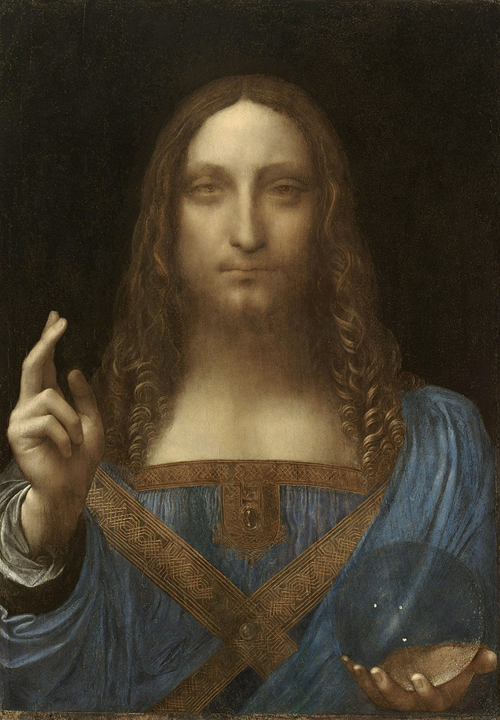
by Donny Abbott on October 14, 2024

The Salvator Mundi painted by Leonardo da Vinci, 1500-1510
In 2012, Israeli artist Nadav Kander set up a camera in London's National Gallery to capture the reactions of people viewing a particular work of art. Over 20,000 visitors filed past, their faces revealing a range of emotions from awe to skepticism, from tears to wonderment. The object of their attention? The Salvator Mundi, a 500-year-old painting whose title means "Savior of the World" in Latin.
The image depicts Christ holding a transparent crystal globe in His left hand, symbolizing His role as the Logos - the Word through which all creation came into being. It's a powerful visual representation of Christ's omniscience and His position outside space and time.
The painting is attributed to Leonardo da Vinci, the quintessential "Renaissance Man." Leonardo was a polymath - an expert in fields ranging from art and anatomy to engineering and hydrology. He was known for his meticulous attention to detail, studying everything from the flight of birds to the tongue of a woodpecker.
Interestingly, Leonardo was somewhat reluctant as a painter, producing no more than 20 paintings in his lifetime. Today, only 14-16 of these are believed to still exist. The Salvator Mundi, if indeed painted by Leonardo, would be one of his later works, created between 1500 and 1510.
The painting's authenticity, however, remains a subject of much debate. While some experts point to telltale signs of Leonardo's mastery - such as the intricate curls of Christ's hair and the sfumato technique that gives the painting its mysterious allure - others note inconsistencies that cast doubt on its origins.
Over the course of the 500-year history of the painting, the ownership of the Salvator Mundi reads like a fascinating historical novel. From the private collection of an English king to a Louisianan art dealer, from a New York auction house to a Saudi prince, this painting has traveled through centuries and continents.
Perhaps the most intriguing chapter in its recent history is its restoration. Art conservator Diane Modestini spent five years (three months on the eyes alone) meticulously restoring the heavily damaged painting, uncovering layers of history and artistry in the process. The restoration process of the painting serves as a powerful metaphor for our own spiritual journeys. Just as Modestini carefully removed layers of dirt and overpaint to reveal the true beauty beneath, God also works in our lives to strip away the accumulated grime of sin to reveal the divine image in which we were created. He takes our brokenness and not only heals it but transforms it into something beautiful that can bring glory to Him and impact others. This idea is beautifully captured in the Japanese art of Kintsugi, where broken pottery is repaired with gold, embracing the cracks as part of the object's history.
This mysterious portrait of Christ has become a symbol of both controversy and spiritual reflection. But beyond its artistic merits, this painting offers us a profound opportunity to contemplate the nature of our true Savior and His role in our lives. While the artistic and historical significance of the Salvator Mundi is undeniable, its true value lies in what it represents. The image of Christ as the Savior of the World reminds us of a fundamental truth of our faith: that in Jesus, we find the ultimate source of salvation and hope.
In Jesus Christ, we have a personal, loving God who is not content to remain distant but instead offers a salvation that addresses the root of humanity's problems: our fallen spiritual condition. Through Christ, we are offered eternal life. Something that is not just a future promise but a present reality, transforming us from the inside out.
As we contemplate the Salvator Mundi - both the painting and the Savior it represents - we're called to respond. Like the visitors to the National Gallery, we may approach with a range of emotions and preconceptions. But ultimately, we're invited to look beyond the canvas to the living Christ. Moreover, just as art experts look for signs of the master's hand in a painting, we're called to allow the Master Artist to work in our lives, transforming us into masterpieces that reflect His glory.
In a world that often looks to political powers or human wisdom for salvation, the message of the Salvator Mundi remains as relevant as ever. Our hope will never be found in earthly rulers or systems, but in Jesus Christ, the true Savior of the World. As we embrace this truth, may we, like a restored masterpiece, reflect His beauty and grace to a world in need of hope.




